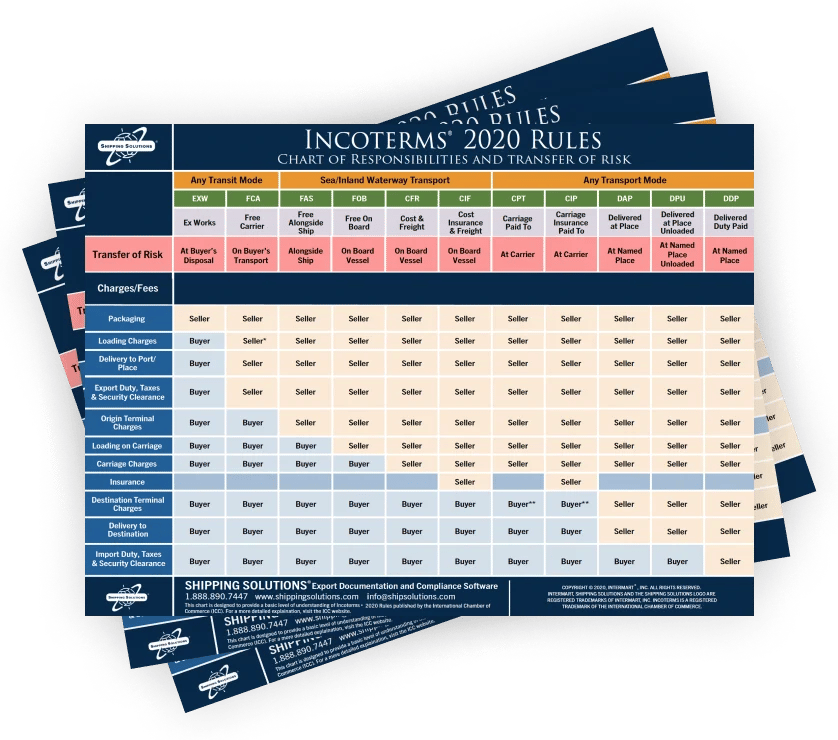The International Trade Blog International Sales & Marketing
FOB vs. FOB: Key Differences in Domestic and International Trade
On: May 19, 2025 | By:  Kari Crane |
7 min. read
Kari Crane |
7 min. read
 FOB means “Free On Board”—simple, right? Not exactly. And for one Shipping Solutions client, that misunderstanding nearly cost them thousands.
FOB means “Free On Board”—simple, right? Not exactly. And for one Shipping Solutions client, that misunderstanding nearly cost them thousands.
The exporter had been shipping domestically for years using “FOB Destination” to indicate they would cover delivery to the buyer’s location. So when they started selling to a customer in Germany, they did what they’d always done: they listed “FOB Destination” on the invoice. What they didn’t realize was that FOB under Incoterms 2020—the standard for international trade—meant something entirely different.
Instead of covering the ocean freight to Hamburg as intended, they would have inadvertently agreed to deliver only to the U.S. port. Their German buyer expected delivery to Europe. Had no one caught the mistake, both sides would have been left frustrated, the shipment sitting at the wrong dock.
FOB is one of the most misused terms in global trade, precisely because it means different things depending on where and how it's used. Let’s unpack what FOB really means in both domestic and international contexts—and how to make sure you’re using the right version in your transactions.
What Does FOB Mean in Domestic U.S. Shipping?
In the United States, FOB terms derive from the Uniform Commercial Code (UCC), the National Motor Freight Classification (NMFC) and industry customs. They’re not defined by a single source or authoritative body, like Incoterms. They specify where title and risk of loss transfer from the seller to the buyer.
Two of the most common variations include:
- FOB Origin: The buyer takes ownership and risk once the goods leave the seller's location.
- FOB Destination: The seller retains risk and ownership until the goods arrive at the buyer's location.
These terms are often paired with freight payment indicators, such as:
- Freight Collect
- Freight Prepaid
- Prepaid & Add
- Freight Allowed
In domestic transactions, risk and title typically transfer at the same time, and freight terms must be explicitly stated.
What Does FOB Mean Under Incoterms 2020?
In international trade, FOB is one of the 11 Incoterms rules established by the International Chamber of Commerce (ICC). These rules help buyers and sellers clearly define responsibilities and costs when moving goods across borders.
Under Incoterms 2020, FOB (Free On Board):
- Is used only for sea and inland waterway transport.
- Specifies that the seller fulfills their obligation when the goods are loaded onto the vessel nominated by the buyer at the named port of shipment.
- Transfers risk to the buyer at the moment the goods are on board.
The buyer is then responsible for ocean freight, insurance and all costs beyond that point. The buyer may select the carrier under FOB. Finally, buyer and seller should agree upon what exactly “loaded on board” means in the sales contract, because it can vary depending on the commodity and type of vessel.
Why the Difference Matters
Mixing up domestic and international meanings of FOB can lead to:
- Unexpected liability for damage or loss
- Unpaid freight charges
- Customs complications
- Contract disputes
As in the story at the beginning of this article, even experienced exporters can fall into the trap of assuming that the FOB they’ve always used domestically will work the same way internationally. It won’t.
That’s why choosing the right term—and understanding what it actually means—is essential.
A Better Alternative for Exporters: FCA (Free Carrier)
For most containerized and multimodal shipments, FCA (Free Carrier) is the better choice over FOB in international trade. It offers more flexibility and can be used for any mode of transport.
Examples:
- FCA Seller’s Facility, Minneapolis, MN USA: Risk transfers when the goods are loaded on the truck at the seller’s location.
- FCA Freight Forwarder’s Warehouse, Miami, FL USA: Risk transfers when goods are delivered to the named location, ready for unloading.
FCA also makes it easier to assign who handles export clearance and inland freight—two tasks that aren’t fully addressed in domestic FOB terms.
Want to Get Incoterms Right? Free Resources to Help
Shipping Solutions has compiled several easy-to-use tools and guides to help you choose the right trade term every time:
- Incoterms 2020 Chart of Responsibilities: A downloadable visual breakdown of buyer and seller responsibilities.
- An Introduction to Incoterms: A beginner-friendly guide that explains each rule.
- Articles on All 11 Incoterms 2020 Rules: In-depth breakdowns of each term.
- Free Incoterms 2020 Webinar: Learn from the experts in this 80-minute overview.
Frequently Asked Questions about FOB
-
What is the difference between domestic FOB and Incoterms FOB?Domestic FOB (UCC) includes title transfer and can apply to any transport mode. Incoterms FOB only applies to sea transport and defines the point of risk transfer, not ownership.
-
Can I use FOB for container shipments?No. Under Incoterms 2020, FOB is not recommended for containerized cargo. Use FCA (Free Carrier) instead, which is better suited for multimodal transport.
-
Does FOB mean the seller pays for shipping?Not necessarily. Domestic FOB terms may require additional phrases like “Freight Prepaid.” Under Incoterms FOB, the buyer pays for ocean freight after the goods are loaded on board.
-
What Incoterm should I use instead of FOB for exports?Use FCA (Free Carrier) for most international shipments, especially those involving containers or multimodal transport.
Don’t let a three-letter acronym throw your entire trade deal off track. While FOB might look familiar, it carries different meanings depending on whether you're shipping domestically or internationally. Knowing the difference—and choosing terms that align with the specifics of your transaction—is essential for avoiding confusion and costly mistakes.
And when in doubt, use the resources above to make sure you’re on solid ground. Your contracts, your shipments and your bottom line will thank you.
Like what you read? Join thousands of exporters and importers and subscribe to the International Trade Blog to get the latest news and tips delivered to your inbox.

About the Author: Kari Crane
Kari Crane is the editor of Passages: The International Trade Blog. Kari joined Shipping Solutions after working as an editor, writer and designer at a major market newspaper in Texas. Kari has spent her career finding different ways to tell stories and make complex topics easy-to-understand, so she loves helping importers and exporters understand how to navigate the complex world of international trade.



